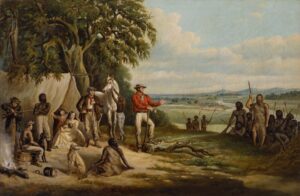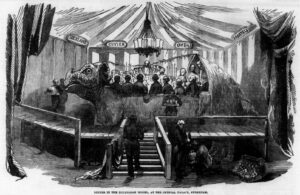As the Russian war in Ukraine drags into its fourth month, Canada and Denmark have resolved a lengthy territorial dispute — one waged primarily with bottles of booze.
Hans Island, a tiny rock between Canada and the Danish territory of Greenland, has been the source of a part squabble, part shared joke for decades. Its legal status has remained ambiguous since the 1930s. Then, Canada and Denmark decided to draw a line between the two countries down the middle of Nares Strait, the waterway between them. They didn’t realize that an obscure little island lay in the middle of that line.
This led to jocular claims of sovereignty by sailors and political representatives. When arriving on the island, they would leave a symbol of their national pride — either Schnapps or Canadian Club whiskey — for the next military ship or research expedition to find.
The dispute showcases the characteristic politeness of the two countries, but the war in Ukraine perhaps persuaded their political leaders to finally settle the territorial ambiguity.

Photo: Creative Commons
Shared ownership
Canada and Denmark plan to unveil their new agreement on June 14, celebrating the announcement as “an example of how countries can resolve border disputes peacefully,” The Globe and Mail reported.
It’s a symbolic gesture, given that the island in question is simply a 1.3-square-kilometer rock in the arctic sea passage between Greenland and Ellesmere Island.
The debate over what to do with Hans Island has received its share of opinions for years. In 2015, a professor from the University of British Columbia joined with a Danish colleague to propose the two countries share the island and give day-to-day management to Inuit from Nunavut and Greenland.

Denmark hoisted a flag on Hans Island in 2003. Photo: Creative Commons
It’s unclear if the two countries plan on embracing that plan, but the new agreement should at least end the low-level friction.
In 1983, Canada issued a land-use permit for Hans Island to a petroleum company to research the effect of sea ice on drilling rigs. That prompted the Danish minister for Greenland to fly to the island the following year and plant a Danish flag, resulting in a diplomatic protest from Canadian officials.
Additional flag plantings — and protests — occurred throughout the 1980s, 1990s, and 2000s. The dispute even attracted the ire of average citizens, who bought online advertisements in 2005, pushing their country’s ownership of the island.
By finally agreeing to share the island, Denmark and Canada will now have a second border. Canada has only ever shared a border with the U.S., and Denmark’s only land border is with Germany.
Shared sovereignty of Hans Island means residents of both countries can step from Canada to Europe and back again, without going through customs — or starting a war.
Given the chaos caused by Russia’s invasion of Ukraine, that’s something worth celebrating.





